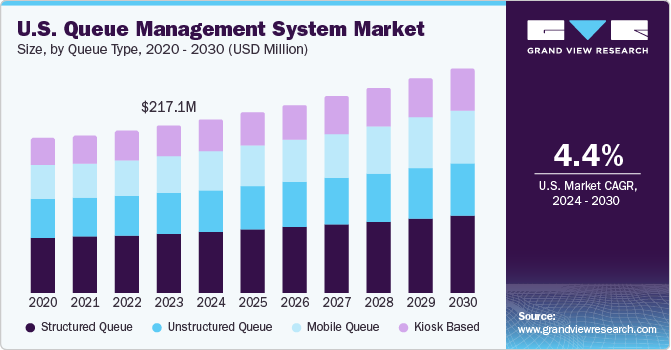Industry Report Insights: Projecting Market Growth (CAGR & Total Market Value)
The global queuing kiosk market is expected to see significant growth by 2030, driven by increasing demand across various sectors such as banking, healthcare, restaurants, and government services, alongside technological advancements. The growth is fueled by accelerating urbanization, innovations in AI and big data, and strong government support for digital transformation. As competition intensifies, companies are increasing their R&D investment to capture market share, which will further expand the market size.
Market Demand: A Growing Scope Across Multiple Industries
As global economies grow and urbanization progresses, the demand for efficient and seamless services continues to rise. Queuing kiosks are becoming indispensable across industries such as banking, healthcare, retail, and government. According to a report by Grand View Research, the global queue management system market was valued at approximately $1.5 billion in 2023, with an expected compound annual growth rate (CAGR) of 6.4%. By 2030, the market is projected to reach $3.5 billion. This growth is largely driven by the integration of AI and IoT technologies, as well as increasing consumer demand for more efficient service experiences.
In China, for example, the queuing kiosk market is expected to reach ¥15 billion in 2023, reflecting a 15% year-over-year growth. With the ongoing digital transformation and the aging population, the market is anticipated to exceed ¥40 billion by 2030.

Technological Innovation: Enabling Smart, Personalized, and Efficient Solutions
Technological advancements in AI, big data, and IoT are key factors in the evolution of queuing kiosks. These technologies enable kiosks to become smarter, more personalized, and highly efficient. For example, kiosks equipped with voice recognition technology can interpret user commands and provide convenient services, such as checking queue status or scheduling appointments. AI algorithms analyze historical data to predict queuing trends, offering decision-making insights that optimize resource allocation and reduce wait times, thereby driving further demand.
Competitive Landscape: Innovation as a Market Driver
The queuing kiosk market is becoming increasingly competitive, with companies ramping up R&D efforts to capture a larger share of the market. To differentiate themselves, companies are launching innovative products, enhancing service quality, and improving product features. This innovation-driven competition will continue to propel market growth, contributing to the overall expansion of the queuing kiosk sector.
Policy Support: Creating a Favorable Growth Environment
Governments around the world are actively promoting digital transformation and the development of smart cities, creating a favorable policy environment for the queuing kiosk market. With ongoing digital initiatives and infrastructure investments, governments are providing valuable opportunities for the growth of this industry.

Key Growth Drivers in the Queuing Kiosk Market
AI Technology: Enhancing User Interaction and Efficiency
AI technology enables queuing kiosks to become more intuitive, personalized, and efficient. Voice recognition allows kiosks to understand user commands, offering services such as checking queue information or scheduling appointments. Additionally, AI-driven natural language processing enhances interactive communication, improving user experience. AI algorithms also predict queuing patterns by analyzing historical data, enabling more efficient resource allocation and reducing waiting times.
IoT Technology: Real-Time Data Sharing and System Integration
IoT technology connects queuing kiosks to other devices and systems, facilitating real-time data sharing and synchronization. Through IoT integration, kiosks can provide up-to-date queue status information across multiple platforms, ensuring users and administrators have access to the same data. Additionally, IoT allows for remote monitoring and management of kiosks, improving operational efficiency and reducing downtime.
Rising Demand for Digital Transformation
As digital transformation accelerates across industries, the demand for queuing kiosks continues to grow. These kiosks act as vital digital service tools, helping businesses and organizations increase service efficiency, streamline workflows, and enhance user experiences. In sectors like banking, healthcare, and retail, queuing kiosks improve service delivery, reduce waiting times, and boost customer satisfaction.
Emerging Market Potential
Emerging markets, especially in rapidly urbanizing developing countries, present significant growth opportunities for the queuing kiosk market. With the rapid expansion of commercial and service sectors, businesses are adopting queuing kiosks to improve customer service and operational efficiency. Furthermore, consumers in these markets are increasingly expecting convenient and efficient services, which drives the demand for smart solutions like queuing kiosks.
Conclusion: A Rapidly Expanding and Competitive Market
The global queuing kiosk market is poised for substantial growth by 2030, driven by increased demand across various sectors, technological innovations, and government policies supporting digital transformation. AI, IoT, and data analytics are transforming queuing kiosks into smarter, more efficient, and highly personalized solutions, further increasing their demand. With intensified competition, Youngtek will continue to innovate to meet evolving customer expectations and strengthen their positions in the expanding market.






